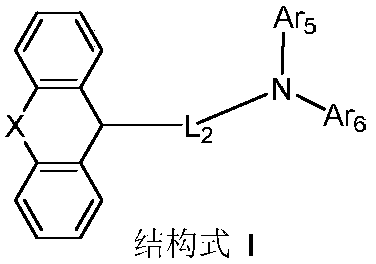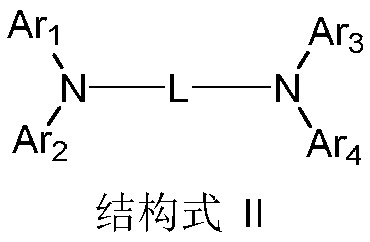An organic electroluminescent device
An electroluminescent device, organic technology, applied in the direction of electric solid devices, electrical components, semiconductor devices, etc., can solve the problem of low light output efficiency
- Summary
- Abstract
- Description
- Claims
- Application Information
AI Technical Summary
Problems solved by technology
Method used
Image
Examples
Embodiment 1
[0169] Synthesis Example 1: Preparation of Compound I-1
[0170]
[0171] Add 10,10-Dimethylanthrone (6.7g, 30mmol) to the round bottom flask, add toluene to dissolve it, add p-toluenesulfonyl hydrazide (8.4g, 45mmol) to the solution, at 80℃ After reacting for 2h under the conditions, add 4-boronic acid triphenylamine (13.0g, 45mmol) and K 2 CO 3 (12.4g, 90mmol), reflux reaction for 5h, the reaction solution was cooled to room temperature, the reaction solution was washed with deionized water, the organic phase was dried, concentrated, and column chromatography to obtain compound I-1 (10.8g, 80%). Mass spectrum m / z: theoretical value: 451.61; measured value: 453.79. Theoretical element content (%) C 34 H 29 N: C, 90.43; H, 6.47; N, 3.10; Measured element content (%): C, 90.41; H, 6.53; N, 3.07. The above results confirm that the obtained product is the target product.
Embodiment 2
[0172] Synthesis Example 2: Preparation of Compound I-2
[0173]
[0174] The 4-boronic acid triphenylamine in Example 1 was replaced with equimolar 4-(dibiphenyl-4-amino)phenylboronic acid, and the other steps were the same as the synthesis of Example 1, to obtain compound I-2 (15.2g ,84%). Mass spectrum m / z: theoretical value: 603.81; measured value: 605.94. Theoretical element content (%) C 46 H 37 N: C, 91.50; H, 6.18; N, 2.32; Measured element content (%): C, 91.45; H, 6.25; N, 2.30. The above results confirm that the obtained product is the target product.
Embodiment 3
[0175] Synthesis Example 3: Preparation of Compound I-11
[0176]
[0177] Add 2-bromotriphenylene (11.5g, 37.5mmol), 2-triphenylamine (9.1g, 37.5mmol), t-BuONa (5.4g, 56.25mmol), Pd to the round-bottomed flask in sequence. 2 (dba) 3 (0.686g, 0.75mmol) and toluene (200mL) deoxygenated ultrasonically, followed by P(t-Bu) dissolved in toluene (3mL) 3 (0.36g, 1.8mmol), reflux overnight under the protection of nitrogen. After the reaction solution was cooled to room temperature, it was treated with ethyl acetate and water, and the obtained organic layer was treated with MgSO 4 After drying and evaporating the solvent under reduced pressure, the crude product was subjected to column chromatography using silica gel as a stationary phase and dichloromethane / hexane as eluent to obtain compound D1 (11.4 g, 65%).
[0178] Under the protection of nitrogen, compound D1 (11.8g, 25mmol), 4-iodophenylboronic acid (6.2g, 25.0mmol), t-BuONa (4.2g, 37.5mmol), Pd were sequentially added to the flask un...
PUM
 Login to View More
Login to View More Abstract
Description
Claims
Application Information
 Login to View More
Login to View More - R&D
- Intellectual Property
- Life Sciences
- Materials
- Tech Scout
- Unparalleled Data Quality
- Higher Quality Content
- 60% Fewer Hallucinations
Browse by: Latest US Patents, China's latest patents, Technical Efficacy Thesaurus, Application Domain, Technology Topic, Popular Technical Reports.
© 2025 PatSnap. All rights reserved.Legal|Privacy policy|Modern Slavery Act Transparency Statement|Sitemap|About US| Contact US: help@patsnap.com



